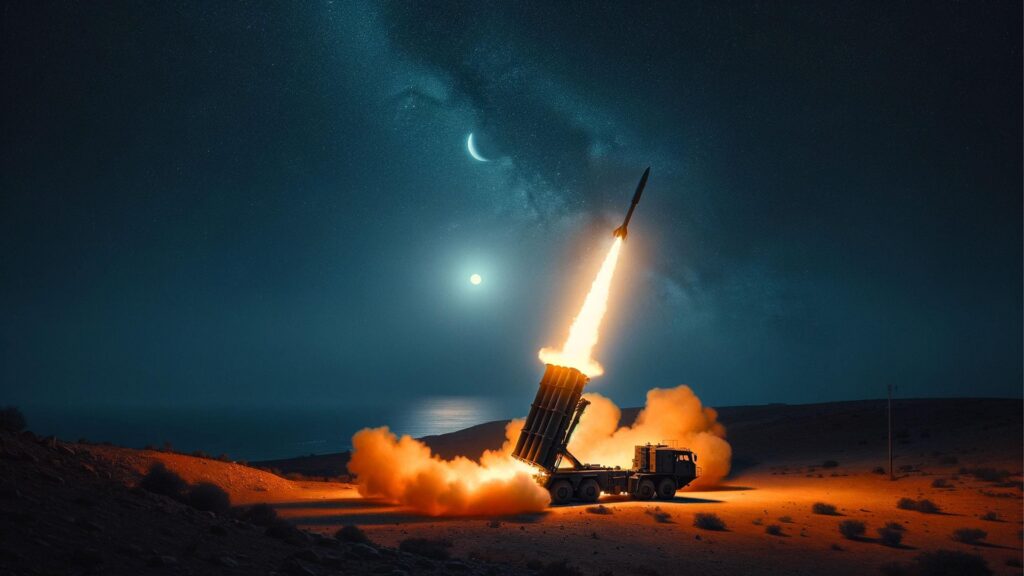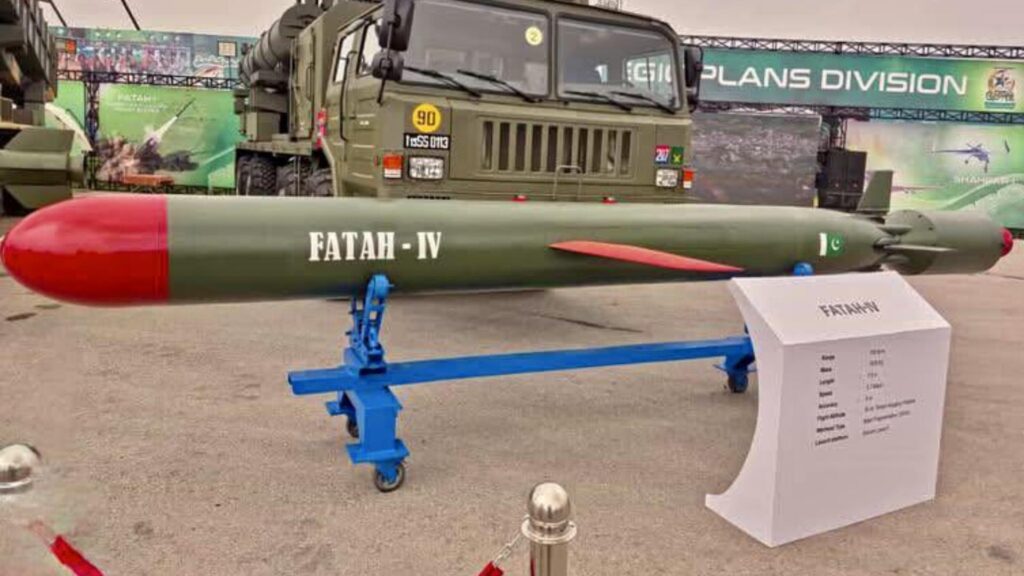Pakistan has achieved another mission in making its defense more strong. On Tuesday, September 30, 2025 Pakistan successfully launched the Fatah 4 Ground-Launched Cruise Missile . This latest test is a big step forward in Pakistan’s ongoing efforts to improve its defense system and boost conventional deterrence.
The Fatah 4, developed inside Pakistan, can hit targets up to 750 kilometers away. With this successful test. The missile now becomes part of the Pakistan Army’s growing arsenal. Its showing the country’s focus on self defense technology and its mission to modernize its military.
Fatah 4 is more than just another missile. It fills an important gap by giving Pakistan a long-range, high-precision strike option without relying on nuclear weapons. This makes the system a powerful tool for strengthening conventional defense.

In this post, we’ll take a closer look at the missile’s features. The importance of its launch, and what it means for Pakistan’s defense strategy. Especially after the creation of the Army Rocket Force Command, which highlights the military’s focus on advanced missile systems.
The Successful Launch Fatah-4
The ISPR confirmed the successful completion of the Fatah 4 training launch. The test was carried out by the Pakistan Army under the supervision of senior officers, along with scientists and engineers.
ISPR described the event as a training launch. It highlights that the missile is now being fully integrated into the newly established Army Rocket Force Command. This also means that Fatah 4 is now officially completely ready for working on the ground in any situation.
The missile successfully hit its target at a range of 750 kilometers. This long term range gives pakistan a huge power to hit the enemy in this range.
This achievement was celebrated by everyone together. All the politicians and military officials congratulated and celebrated this great achievement together.
Read More : Saudi Arabia-Pakistan Defence Pact: A Game-Changer for Regional Geopolitics
Understanding the Fatah-4: Pakistan’s Indigenous Cruise Missile
The Fatah 4 is the newest and most advanced version in Pakistan’s indigenous “Fatah” weapons family. Which originally started with guided artillery rockets. Unlike its earlier versions, the Fatah 4 marks a major step forward. It is not just an upgrade but a complete shift in doctrine, moving toward a dedicated, long-range Ground-Launched Cruise Missile (GLCM).
Technical Specifications and Advanced Features
Unlike ballistic missiles, which travel in a fixed arc high into space before falling back down. The Fatah 4 cruise missile flies very differently. It stays within the atmosphere, is powered throughout its flight, and can change direction while in the air. This ability to maneuver makes it much harder to track and destroy, giving it a far better chance of surviving enemy defenses.

1. Range and Payload
The missile’s 750 km range gives Pakistan a strong conventional reach. It can reportedly carry a 330 kg high-explosive warhead, built to destroy important, well-protected targets things like command centers, airbases, missile sites.
2. The Key to Survivability
The most important feature of the Fatah 4 is its ability to fly very close to the ground. It can reportedly go as low as 50 meters (164 feet) above the surface, adjusting its path to follow the shape of the terrain. This low-altitude flight is a key advantage because it makes the missile much harder to detect and intercept.
- Radar Evasion: It exploits the curvature of the Earth and ground clutter, allowing it to remain.
- invisible to most conventional ground-based radars until seconds before impact.
- Defense Penetration: By flying “under the radar,” it significantly reduces the window of opportunity. for enemy air defense and missile interceptors, complicating interception efforts against advanced systems like the S-400.
3. Precision Guidance Systems
The Fatah 4 comes with advanced avionics and modern navigation systems to make sure it strikes targets with high accuracy. According to defense experts. Its likely uses a hybrid navigation setup, which may combine different technologies to guide it reliably throughout its flight.
- Inertial Navigation Systems (INS): Provides reliable mid-course guidance.
- Satellite Navigation (GPS/BeiDou): Ensures global positioning accuracy.
- Electro-Optical/Infrared (EO/IR) Seekers: Potentially adapted from the existing Babur/Harbah missile family, these seekers use image recognition for precise terminal guidance, giving the missile a reported accuracy of under 5 meters Circular Error Probable (CEP). This level of precision rivals some of the world’s leading cruise missiles.
This combination of low-altitude flight and high accuracy means the Fatah 4 is a true conventional precision-strike weapon.
Strategic Significance: Why Fatah-4 is a Game-Changer
The induction of the Fatah 4, especially within the new military command structure, has profound implications for Pakistan’s conventional deterrence strategy and the regional strategic balance.
1. Cementing Conventional Deterrence
Pakistan’s long-standing defense posture, known as “Full Spectrum Deterrence,” aims to deter all forms of aggression. A key challenge is often the potential for escalation control in limited conflicts. The Fatah 4 addresses this by providing a highly credible, long-range, non-nuclear option.
- Raising the Cost of Conflict: By holding key military infrastructure deep inside adversary territory at risk with a conventional, high-precision weapon. Pakistan significantly raises the potential cost of any limited conflict for an aggressor.
- Preserving the Nuclear Threshold: The missile’s specific role as a conventional asset means Pakistan can execute deep-strike missions without crossing the nuclear threshold, thus maintaining escalation control and maximizing strategic flexibility. The Fatah 4 allows the nuclear-capable assets to remain reserved for purely strategic deterrence purposes.
Read More : Gaza Ceasefire : Trump’s 3 to 4 Day Warning to Hamas
2. The Role of the Army Rocket Force Command (ARFC)
The Fatah 4’s successful test is intrinsically linked to the August 2025 announcement of the new Army. Rocket Force Command (ARFC). This command is designed to:
- Centralize Conventional Missiles: The ARFC is specifically tasked with overseeing the command, control, and deployment of conventional missiles and rockets within the Pakistan Army. This separates the operational control of non-nuclear strike systems from the Strategic Forces Command (SFC), which manages nuclear-capable systems.
- Enhance Operational Readiness: By centralizing and dedicating a command structure solely to conventional missile warfare, the ARFC streamlines decision-making, improves training standards, and allows for faster deployment and reaction times.
- Modernizing Doctrine: The ARFC’s creation signifies a doctrinal shift towards non-contact warfare—relying more heavily on long-range precision fires to disrupt and degrade the enemy’s warfighting capability before front-line forces clash.
The Fatah 4 is now the flagship asset of this new command, demonstrating its capability to project power effectively and independently.
3. Implications for the Regional Balance
The 750km range and the terrain-hugging feature directly counter the investments made by regional rivals in advanced Ballistic Missile Defense (BMD) systems. BMD systems are primarily designed to intercept high-altitude ballistic missiles. The Fatah 4, with its low, maneuverable flight profile, is a potent solution to preserve a credible strike capability against a layered air defense network.
Analysts view the Fatah 4 as a direct effort to ensure that Pakistan’s deterrent remains robust against a backdrop of increasing regional defense expenditures and long-range strike developments. Its induction accelerates the ongoing precision-strike competition in South Asia, forcing adversaries to divert resources to counter a threat that is mobile, evasive, and highly accurate.
Beyond the Launch: The Future of Pakistan’s Missile Program
The successful Fatah 4 test is not an isolated event but a marker in Pakistan’s long-term commitment to technological self-reliance and the continuous modernization of its armed forces.
The Fatah missile series has shown a clear evolutionary path, moving from guided rockets (Fatah-I/II) to the cruise missile class with the Fatah 4. This progression demonstrates robust domestic expertise in propulsion, guidance, and airframe technology.
The focus will now shift to mass production, seamless integration of the Fatah 4 into the ARFC’s operational plans, and continued training to perfect deployment and targeting procedures. As the world moves further into an era dominated by precision strikes and non-contact warfare, systems like the Fatah 4 ensure that Pakistan’s military remains a capable force, ready to respond effectively to modern security challenges.
Conclusion: A Stronger Foundation for National Security
The successful training launch and induction of the Fatah 4 Ground-Launched Cruise Missile is a monumental achievement for Pakistan’s scientific and military communities. The 750km range, combined with its advanced terrain-hugging and precision guidance capabilities, makes it a powerful strategic asset for conventional deterrence.
By bolstering the operational strength of the new Army Rocket Force Command, the Fatah 4 solidifies Pakistan’s capability to deliver accurate, deep-penetrating conventional strikes while carefully managing the dynamics of escalation. This successful test is a powerful statement of defense self-reliance and a crucial step in ensuring the nation’s security remains impregnable in a rapidly evolving regional landscape.
Fatah-4 Missile Test FAQs
1. What is the Fatah-4 missile?
Pakistan Army recently inducted the indigenously developed Fatah-4 ground-launched cruise missile (GLCM) into its arsenal to carry out high-precision conventional strikes.
2. What is the range of the Fatah-4 missile?
The Fatah-4 missile has a maximum range of 750 kilometers (470 miles).
3. What is the missile’s most significant technical feature?
Its most significant feature is its terrain-hugging capability. Which allows it to fly at very low altitudes to evade detection by conventional enemy radar and missile defense systems.
4. Which new military command is the Fatah-4 integrated into?
The Fatah-4 is a key asset of the newly established Army Rocket Force Command (ARFC). A dedicated command for managing Pakistan’s conventional missile and rocket systems.
5. What is the strategic purpose of this missile?
Its strategic purpose is to enhance conventional deterrence by providing a precise, deep-strike option against high-value military targets, ensuring that Pakistan can respond effectively to threats without immediately resorting to nuclear-capable systems.



